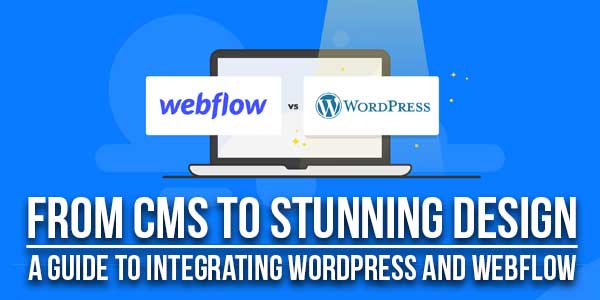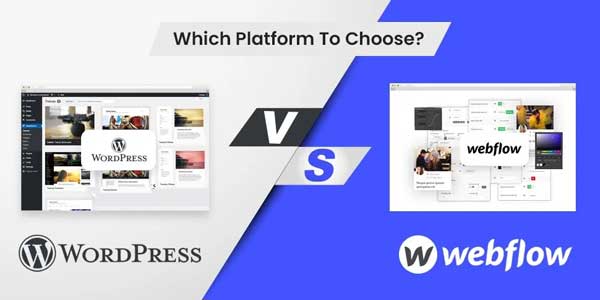
In today’s fast-paced digital landscape, having a powerful website is essential for businesses and individuals alike. The synergy between a robust content management system (CMS) like WordPress and the creative process of Webflow designers has opened up new horizons in web development. This article explores the seamless integration of WordPress and Webflow, showcasing how this dynamic duo can elevate your web development game to create stunning designs and exceptional user experiences.
Table of Contents
The Power Of WordPress Development:
WordPress has long been a favorite CMS for website developers due to its user-friendly interface, vast plugin library, and active community support. Its flexibility allows users to create various types of websites, from simple blogs to complex e-commerce platforms.
With WordPress, developers can effortlessly manage content, add new pages, and update existing ones without the need for extensive technical knowledge. Its robust architecture enables the incorporation of custom themes and plugins, making it an ideal choice for developers seeking scalable and customizable solutions.
Moreover, WordPress development empowers users with search engine optimization (SEO) capabilities, ensuring that websites can rank higher on search engine result pages, thereby driving organic traffic and enhancing online visibility.
Unleashing Webflow Designers’ Creativity:
Webflow, on the other hand, stands out as a powerful visual web design platform that puts creativity at the forefront. It allows designers to craft visually stunning websites without writing a single line of code. Webflow’s intuitive drag-and-drop interface, coupled with a plethora of customizable templates and interactions, gives designers the freedom to create captivating user experiences.
Webflow designers can unleash their creativity, effortlessly exploring a vast array of animations, responsive designs, and engaging interactions. The platform provides a pixel-perfect design environment that bridges the gap between concept and realization, allowing designers to bring their visions to life with ease.
The Perfect Integration: Where WordPress Meets Webflow:
Integrating WordPress and Webflow offers the best of both worlds: the robust backend management of WordPress and the visually striking design capabilities of Webflow. This integration enables developers and designers to collaborate effectively, providing clients with a holistic solution that fuses powerful functionalities with captivating aesthetics.
With WordPress serving as the CMS, content creation, updates, and data management become a breeze. Meanwhile, Webflow designers can focus on crafting visually stunning layouts and user interfaces, ensuring a seamless and immersive experience for website visitors.
Elevating Web Development With The Dynamic Duo:
1.) Enhanced Customization And Branding:
WordPress and Webflow integration empowers businesses to create a unique online identity. Webflow designers can meticulously design websites that resonate with the brand’s identity, providing a memorable experience for users. By utilizing custom WordPress themes, businesses can ensure that their websites reflect their unique personality and brand image.
2.) Optimized SEO Performance:
The combination of WordPress and Webflow can significantly enhance SEO performance. WordPress’s SEO-friendly architecture, coupled with Webflow’s responsive and fast-loading designs, creates a winning formula for ranking higher in search engine results. Webflow’s clean code and optimized design elements contribute to improved page load times, a critical factor for SEO success.
3.) Seamless E-commerce Solutions:
For businesses looking to sell products online, the integration of WordPress and Webflow can streamline the e-commerce process. WordPress’s extensive e-commerce plugins, such as WooCommerce, seamlessly blend with Webflow’s engaging product pages and checkout experiences, creating an immersive shopping journey for customers.

Implementing The Integration:
Integrating WordPress and Webflow requires a careful approach, and collaboration between developers and designers is key.
Here are some steps to consider:
Define Project Goals And Requirements:
Understand the client’s needs and goals for the website. Determine the functionalities required from WordPress plugins and Webflow interactions to create a comprehensive project plan.
Develop A Solid Information Architecture:
Create a clear sitemap and define how content will be structured on the website. This step helps streamline the integration process and ensures an organized user experience.
Choose The Right Plugins And Tools:
Select suitable WordPress plugins that align with the project requirements. Similarly, identify Webflow interactions and animations that enhance the website’s visual appeal and user engagement.
Develop Custom WordPress Themes:
Designers can create custom WordPress themes that seamlessly integrate with Webflow’s design elements. Custom themes ensure a consistent and cohesive user experience throughout the website. Make sure you choose from the top WordPress development companies experienced in integrating custom solutions into websites.
Perform Rigorous Testing:
Thoroughly test the integrated website across various devices and browsers to ensure compatibility and responsiveness. Address any bugs or issues to deliver a polished final product.
Conclusion:
Integrating WordPress and Webflow empowers web developers and designers to create exceptional websites that marry functionality with stunning design. The dynamic duo of WordPress development and Webflow design opens up a world of possibilities, from enhanced customization to optimized SEO performance and seamless e-commerce solutions. By harnessing the strengths of these two platforms, businesses and individuals can elevate their web development projects and deliver unforgettable user experiences.
So, embrace the powerful combination of WordPress and Webflow, and watch your web development endeavors soar to new heights!

 About the Author:
About the Author:
















Be the first to write a comment.